Author: Do Dive, DeSpread Research
Disclaimer: The contents of this report reflect the views of the respective authors and are for reference only and do not constitute a recommendation to buy or sell tokens or use the protocol. Nothing in this report constitutes investment advice and should not be construed as such.
1. Overview of Liquidity Staking Services
In blockchain networks that adopt the Proof of Stake (PoS) consensus algorithm or similar mechanisms (such as Ethereum), to participate in the block verification process, a certain amount of native tokens must be staked. Although staking occupies a large amount of funds, thereby enhancing the security of the chain, it also brings about a problem that the staked funds cannot be used elsewhere, resulting in reduced capital efficiency.
Liquidity staking was launched to solve this problem. The service it provides allows subscribed assets to be liquid and participate in the block verification process without losing liquidity. Liquidity staking services typically provide users with the following features to unlock the capital efficiency of pledged assets:
Tokenization of pledged assets: When users pledge assets through liquidity staking services, they receive derivative tokens (such as stETH) corresponding to the pledged assets.
Value guarantee and reward distribution: Derivative tokens guarantee 1:1 redemption with underlying assets. Holders of these tokens can receive block validation rewards through mechanisms such as resets or exchange rate adjustments.
Liquidity and asset utilization: Users can leverage the value of derivative tokens in various decentralized applications (dApps), such as using them as loan collateral or providing liquidity in DeFi scenarios.
Participating in block validation on some chains has a large entry barrier. For example, becoming an Ethereum validator requires a capital investment of 32 ETH (worth over $10,000), and Solana validators must bear high hardware costs due to the high specifications of the chain.
Liquidity staking services address these obstacles by allowing more users to participate in the block validation process, bringing benefits to both the chain and users, including:
Increase security: Staking more native tokens strengthens the security of the chain.
Increase capital efficiency: Users earn block validation rewards while using their collateral assets in DeFi.
1.1. The role of liquidity staking
Lido Finance, launched in December 2020, is a pioneer in liquidity staking services for the Ethereum ecosystem. In April 2023, the Ethereum Shanghai upgrade enabled the ability to withdraw ETH on the Beacon Chain. As the market recovers, the amount of ETH staked through the liquidity staking service has increased dramatically.
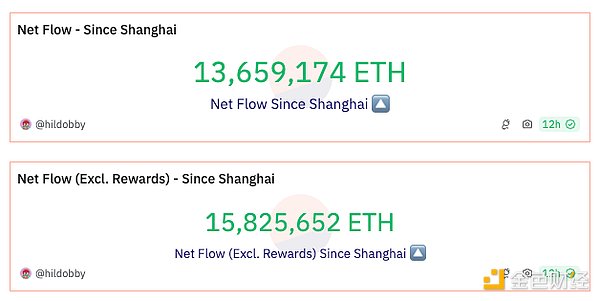
Source: @hildobby dune dashboard
According to the dune dashboard provided by hildobby, after the Shanghai upgrade, as of the end of July 2024, approximately 15.8 million ETH was escrowed, exceeding the 13.6 million ETH before the upgrade. Considering that the Ethereum mainnet was launched in 2015, these numbers prove that the demand for Ethereum staking has increased dramatically in the 15 months after the Shanghai upgrade. In addition, about 32.6% of Ethereum stakes are currently processed through liquidity staking services, highlighting the important role these services play in the on-chain ecosystem.

All protocol TVL trends, source: Defillama

Liquidity staking TVL trends, source: Defillama
According to DefiLlama, liquidity staking services account for more than half of the total locked value (TVL) of all protocols, and their dominance is evident. Lido Finance alone has the highest TVL of all protocols at approximately $32.7 billion.
Key indicators as of August 1, 2024:
Total TVL: $99.16 billion
Liquidity pledge TVL: $50.7 billion
Lido Finance TVL: $31.2 billion (ranked first among all protocols, second is EigenLayer, at $15.5 billion)
Ethereum pledged: approximately 34 million ETH
Liquidity utilization rate: approximately 11 million ETH (accounting for 32.6% of the total ETH pledged)
2. Stacks’ Proof of Transfer (PoX) and Liquidity Staking
Even chains that do not adopt the Proof of Stake (PoS) mechanism can create a favorable environment for liquidity staking protocols if part of their consensus mechanism involves the process of locking tokens or delegating to validators. Stacks, which uses the Proof of Transfer (PoX) consensus mechanism, is such an example.
The PoX algorithm in the Stacks blockchain is characterized by the interaction between miners and Stackers. Miners send Bitcoin (BTC) to Stackers to gain the right to create Stacks blocks and receive STX rewards. Stackers need to lock a certain amount of STX to receive BTC rewards. For more details, please refer to "Stacks Nakamoto Upgrade, a Butterfly Ready to Emerge".
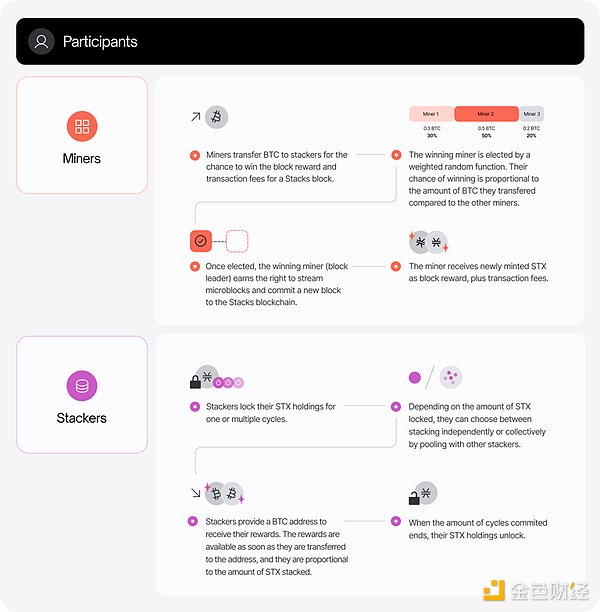
The roles of miners and Stackers, source: stacks docs
Initially, Stackers only need to lock STX tokens to participate in the PoX process. However, after the Nakamoto upgrade scheduled for the second half of this year, Stackers will play a new role called Signer. Signer will be responsible for verifying, storing, signing and propagating Stacks blocks generated during the miner's term.
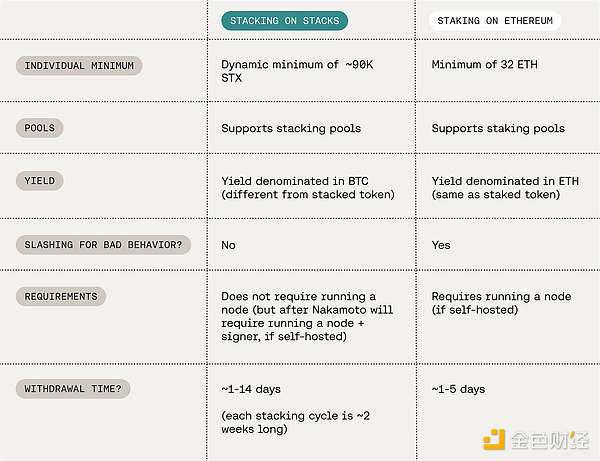
Stacking vs Staking, source: Hiro blog
As shown in the figure, the "Stacking" process in Stacks is similar to the "Staking" process in Ethereum: 1) Both involve locking tokens to participate in the consensus mechanism on the chain; 2) Both require a large number of native tokens, and after the Nakamoto upgrade, Stacker also requires the operation of nodes, creating an entry barrier; 3) Both require locking assets for a certain period of time and setting a withdrawal period, reducing capital efficiency, all of which highlight the need for liquidity staking services.
3. Liquidity Staking Service: StackingDAO
3.1. Stacking Mechanism and the Role of StackingDAO
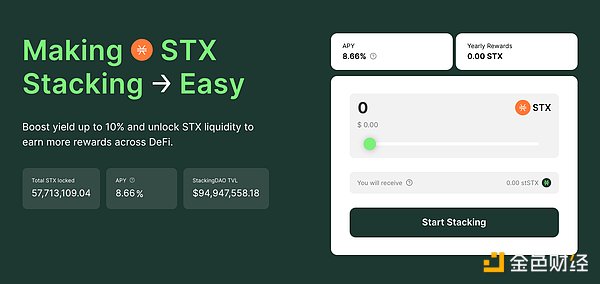
Source: StackingDAO
StackingDAO is a decentralized application (dApp) that provides liquidity staking services for the Stacking process on Stacks. Similar to other liquidity staking services, users can deposit their STX tokens into StackingDAO, participate in the Stacking process, and earn an annual yield (APY) of approximately 8% (benchmarked at 7%) by obtaining derivative tokens of stSTX.
The Stacking mechanism on Stacks is similar to Ethereum’s staking process, both of which introduce difficult barriers to entry:
Stacking cycle: Stacking is based on a two-week cycle, resulting in time limits for locking, unlocking, and restacking.
Minimum STX requirement: Registering as a Stacker requires at least about 90,000 STX tokens.
Node operation: After the Nakamoto upgrade, Stackers need to run nodes.
The two-week cycle brings time inconvenience to users because they have to lock or unlock their assets according to the cycle. In addition, if a user only wants to unlock part of the assets, they must first unlock all of the assets and then re-lock the remaining part, adding complexity.

To address these challenges, StackingDAO has designed an exit mechanism that lowers the barrier to entry while also reducing the impact on Stacking yields. Its main features include:
Diversified Stacking addresses: StackingDAO distributes STX to 10 different Stacking addresses to mitigate the impact on yields.
Staggered withdrawals: Only one of the 10 addresses is unlocked per Stacking cycle, allowing staggered withdrawals based on user requirements.
Issuance of NFTs: When a user requests a withdrawal, they send stSTX to the protocol, which issues an NFT as a receipt. After the Stacking cycle ends, users can burn NFTs to redeem unlocked STX tokens.
This mechanism reduces time constraints and inconveniences in the Stacking process, ensuring that users can acquire and use assets more flexibly while maintaining Stacking benefits.
3.2. Growth and Key Metrics
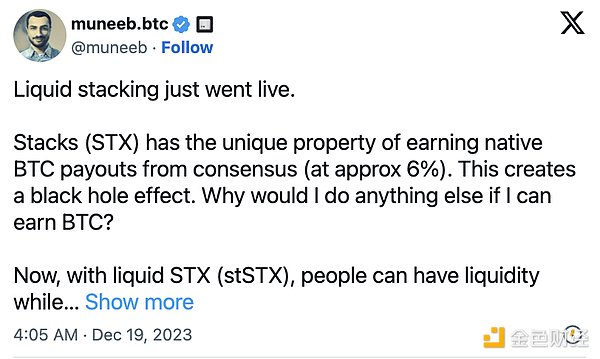
Muneeb announces the launch of StackingDAO, source: Muneeb X
Since its launch in December 2023, StackingDAO has effectively gained attention by introducing a points system, attracting rapid growth in users and capital. The points system rewards users daily based on the stSTX they hold, encouraging stSTX to be pegged to STX and used in DeFi protocols: 1 point for each stSTX token held 1.5 points for each stSTX token deposited in DeFi protocols 2.5 points for each stSTX token deposited in the Bitflow stablecoin exchange pool Key metrics as of August 21, 2024: Total stSTX issued: Approximately 56.8 million stSTX's DeFi utilization rate: 45% stSTX's TVL in DeFi: $36.78 million Total points issued: approximately 14.95 billion Total number of users: 37,498 StackingDAO, as the first liquidity staking dApp in the Stacks ecosystem, reached a peak TVL of nearly $125 million shortly after its launch. Despite the market correction, StackingDAO's TVL remains at around $80 million, making it the dApp with the largest amount of funds in the Stacks ecosystem.
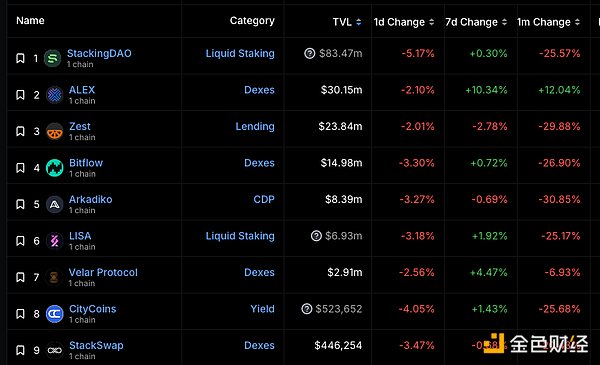
Stacks dApp TVL ranking, source: Defillama
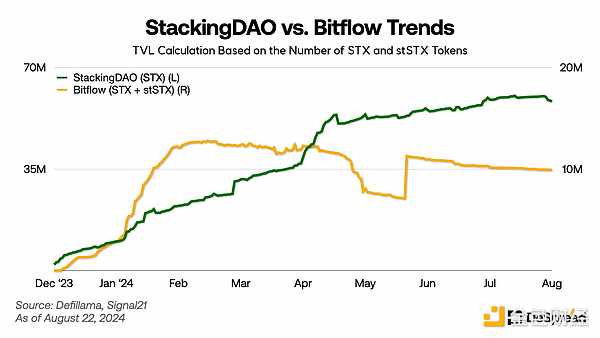
Bitflow, a stable trading protocol that provides the necessary maintenance of stSTX value, also benefited from the launch of StackingDAO and the introduction of the points system. Currently, about 10.5 million STX tokens are deposited in the protocol, highlighting its growth momentum.
StackingDAO TVL calculated in STX tokens has been on an upward trend since its launch, with about 58.6 million tokens currently deposited. This represents approximately 4% of the total circulating supply of 1.48 billion STX and approximately 13% of the 425 million STX tokens currently participating in Stacking, which is a considerable figure considering that the dApp has been launched for less than a year.
3.3. Contribution to the Stacks Network: StackingDAO V2
Starting in late August, as the activation phase of the Nakamoto upgrade is in full swing, Stackers will transition to the role of Singers responsible for validating Stacks blocks. Signers are similar to validators in Proof of Acceptance (PoS) chains, so enhancing the stability and diversity of the Signer network has become a key goal to improve the security and decentralization of the Stacks blockchain after the Nakamoto upgrade.
Against this backdrop, StackingDAO has launched StackingDAO V2, which aims to simplify the onboarding process for Signers. A key feature of this update is the delegation of STX tokens deposited into StackingDAO to new signers on the Stacks blockchain, thereby promoting the growth of the network. The update was originally announced in March and was planned to be implemented after the Nakamoto upgrade is completed.
StackingDAO V2 is built around a mechanism where STX tokens deposited by users are delegated in proportion to the performance of the Signer, which is designed to achieve the following goals:
Improve network performance: Delegating STX staked amounts to different Signers to enhance the diversity of the Signer network and incentivize Signers to improve performance.
Improve user returns: More STX staked amounts will be delegated to higher performing Signers, providing users with higher stacking returns.
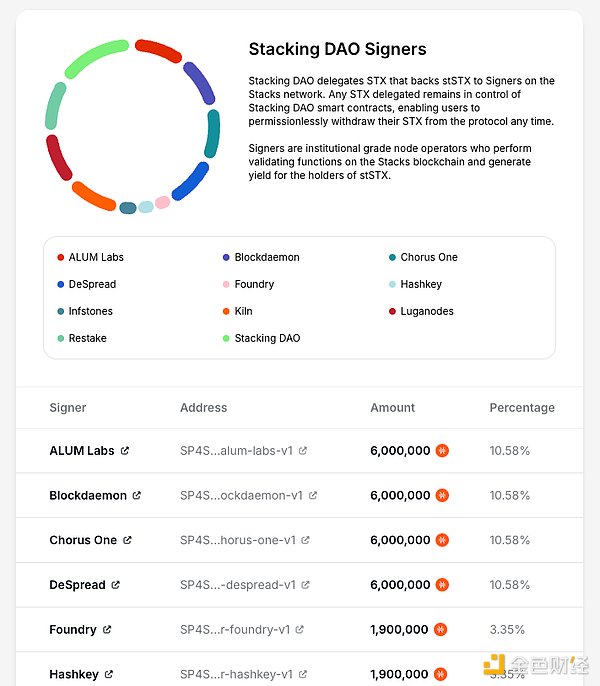
Status of Signers who have joined StackingDAO, source: StackingDAO
Even now, before the full activation of the Nakamoto upgrade, 10 entities (excluding StackingDAO) have joined the StackingDAO Signer program, and delegation amounts have been allocated to these Signers since May. After the release of the Nakamoto upgrade, the scope of Signers joining through StackingDAO is expected to expand, which will further enhance the diversity of the Signer network.
4. Conclusion
At the beginning of this year, as people's interest in the Bitcoin ecosystem surged, the Stacks network and other projects also received a lot of attention. This attention has driven the growth of the Stacks network’s total value locked (TVL), which peaked at $180 million in April, an 18x increase from the $10 million TVL recorded in September of the previous year.
However, as the broader market entered a correction phase, a series of challenges within the Stacks ecosystem occurred one after another. These included delays in the Nakamoto upgrade and the hack of Alex, the largest decentralized exchange in the Stacks ecosystem. Despite these setbacks, emerging projects such as StackingDAO, Zest, Bitflow, and LISA continued to accumulate TVL and achieve growth, and with the Nakamoto upgrade set to be completed in September, the market is once again optimistic about the future of the Stacks ecosystem.

Source: Hiro blog
The Nakamoto upgrade is about to be realized, and the evolution of the Stacks ecosystem is worth watching. We can also wait and see how StackingDAO, which has the largest TVL in the ecosystem, will develop. How StackingDAO can successfully become a liquidity magnet in Stacks DeFi will be the key in the next few months.
 JinseFinance
JinseFinance



















